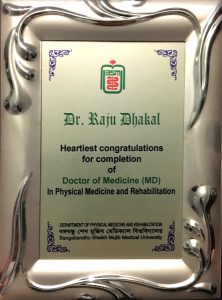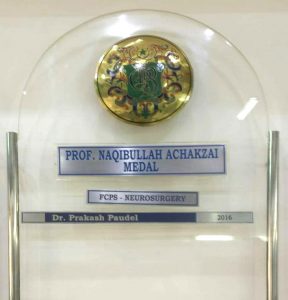2017
2017 marked the completion of our first major goals
During 2017, our two grantees, who have now completed their specialty training, gained further subspecialty skills this year with time spent in conferences and what we might best term observerships or mini-fellowships. Both have now been appointed to positions recognizing their skills and are contributing to health care in Nepal.
At the close of 2017, we were exploring the options for future directions for SpiNepal. Our support of SCI care was clearly still needed and appreciated in Nepal, with plans proceeding slowly but surely towards the beginning of a Rehabilitation Medicine residency training program and ongoing support for spine surgical education. We wanted to contribute seed funding for these training programs and to continue support for other patient program needs at SIRC. To this end, our Vancouver friends Dave and Darby (who came to Nepal with us in May) held a fundraiser in late October. It was a warm sunny day, the sun glowing on their prayer-flag-bedecked house. A silent auction of art and other items, sale of jewellery and textiles, and Dave’s great cooking made for a very convivial get together with many friends coming by. The need for ongoing encouragement of our friends involved in the care of those with spinal injuries in Nepal continues, and the willingness of our SpiNepal supporters continues unabated.
Here are some highlights of the last year:
February 2017
A major goal was achieved when Raju passed his final examination on the first try leading to an MD degree in Physical Medicine and Rehabilitation (the equivalent of the Canadian Fellowship specialty examination): Nepal’s first! His final graduation requirement was to complete and defend his dissertation in April, and he planned to stay in Dhaka until then, participating in an ultrasound course and attending regular rounds and academic sessions at the hospital. He planned to return to Kathmandu around the middle of April, perhaps missing celebrations of the 15th anniversary of the SIRC (see below).
Raju sent a brief note of relief to us all which you can still read here.
Prakash renewed his contract as a junior neurosurgeon for another 6 mos at Bir teaching hospital in Kathmandu; he was performing an increasing number of spine cases with Dr Prakash Bista, his teacher, enhancing his surgical skills. He also submitted a case report for consideration for publication.
The requirements to enter employment in a Nepalese government hospital being quite strict 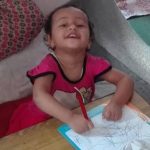 (requiring five years of experience excluding specialty training), he was considering work in a private or semiprivate hospital. He was still interested in completing a spine surgery fellowship. On the home front, little Ritika (right) was now walking and chattering away.
(requiring five years of experience excluding specialty training), he was considering work in a private or semiprivate hospital. He was still interested in completing a spine surgery fellowship. On the home front, little Ritika (right) was now walking and chattering away.
We lost a great man 7 February 2017: renowned Swedish public health physician Dr Hans Rosling, who succumbed to cancer at the age of 68. We heard him speak a number of times on the subject of world health using United Nations/World Health Organization data which he presents most eloquently using specific software developed through the Gapminder Foundation. If you have not heard him speak, spend an hour or so on one or both of these videos:
https://www.gapminder.org/videos/dont-panic-end-poverty/
https://www.gapminder.org/videos/dont-panic-the-facts-about-population/
….after which you may wish to check out his TED talks, or to download the Gapminder software and enjoy manipulating the data yourself.
April-May 2017
Raju successfully completed and defended his research thesis (comparing two conservative treatments for low back pain) on April 15. He and Sheela packed up for the last time and moved home to Kathmandu. He joined the SIRC staff again, this time with clinical and administrative responsibilities as the senior physician and only physiatrist (trained rehabilitation specialist) practicing in Nepal. He returned to work with the patients, with administration, the care team and, of course with the two staff doctors there. Volunteer physiatrist Dr Christine Groves was a wonderful mentor for Raju at this stage.
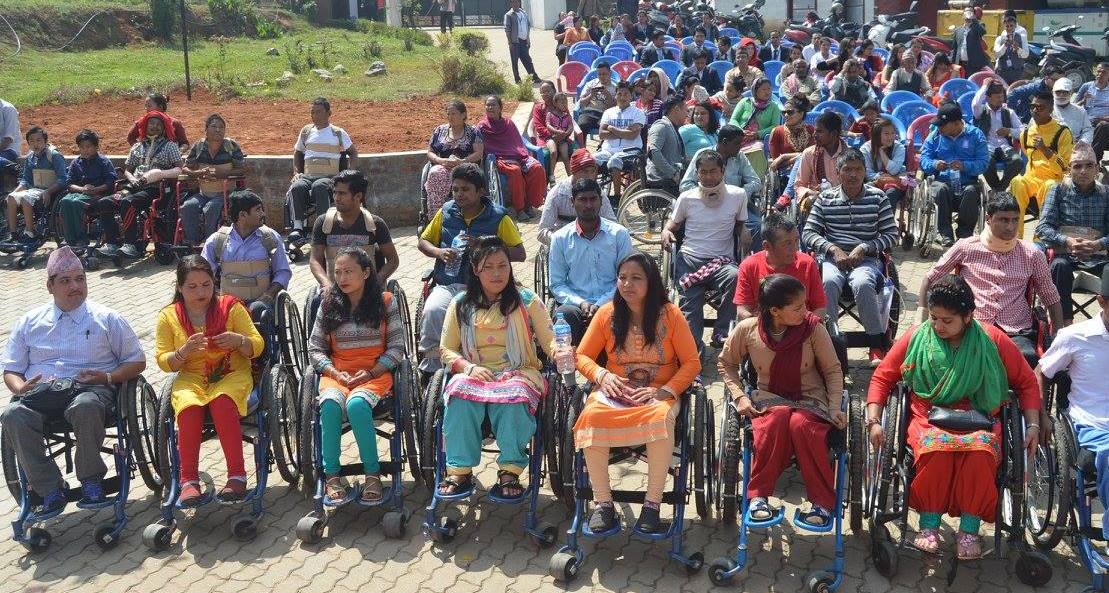
Happy birthday: SIRC celebrated its 15th anniversary in April! SIRC marked its 15th anniversary with a celebration, parts of which are described in Kate Coffey’s blog, with more photographs in the SIRC Facebook page. Here, you see some of the attendees at the SIRC ceremonies outside the facility. (photos courtesy of SIRC, Maggie Muldoon)
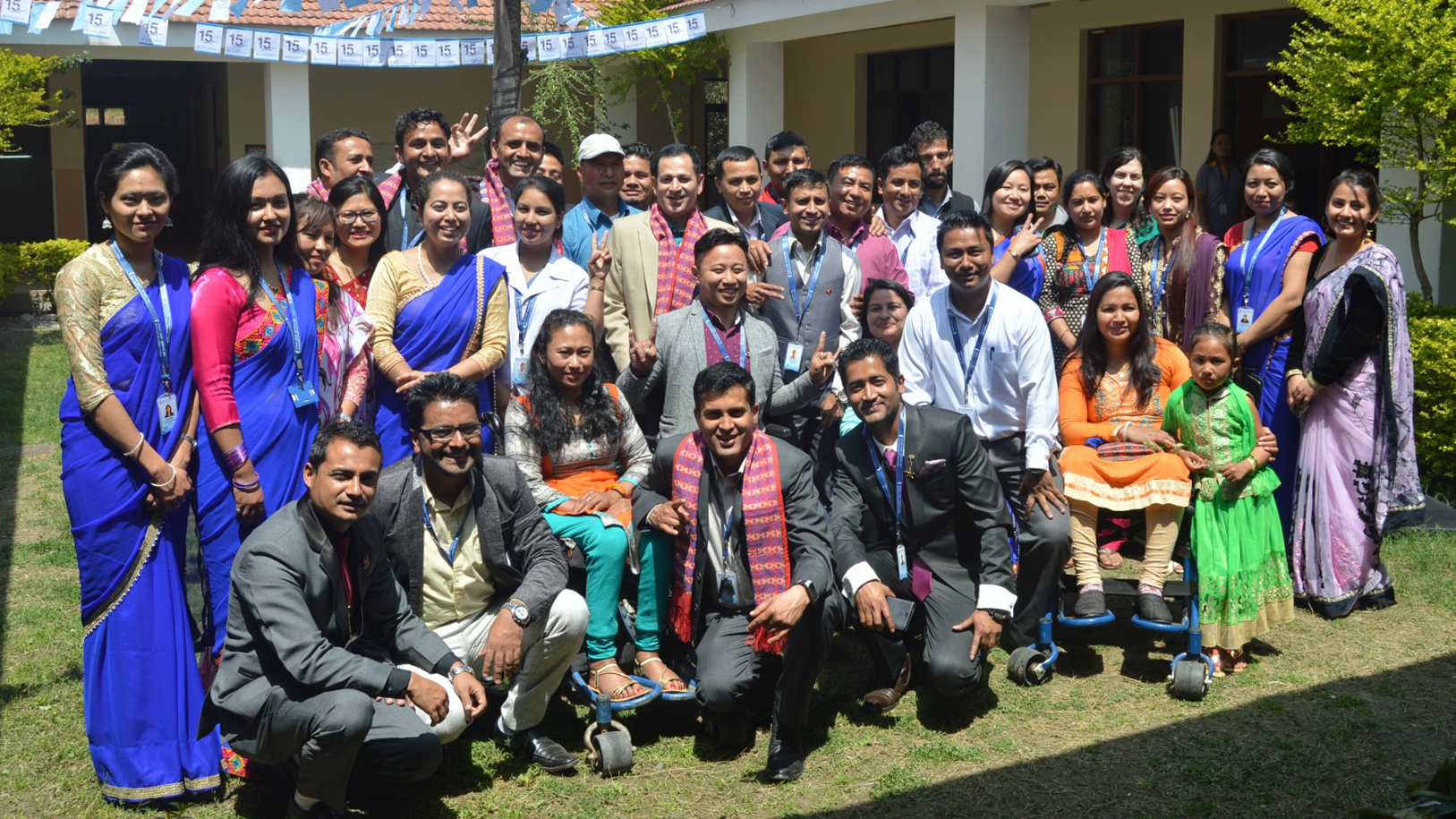
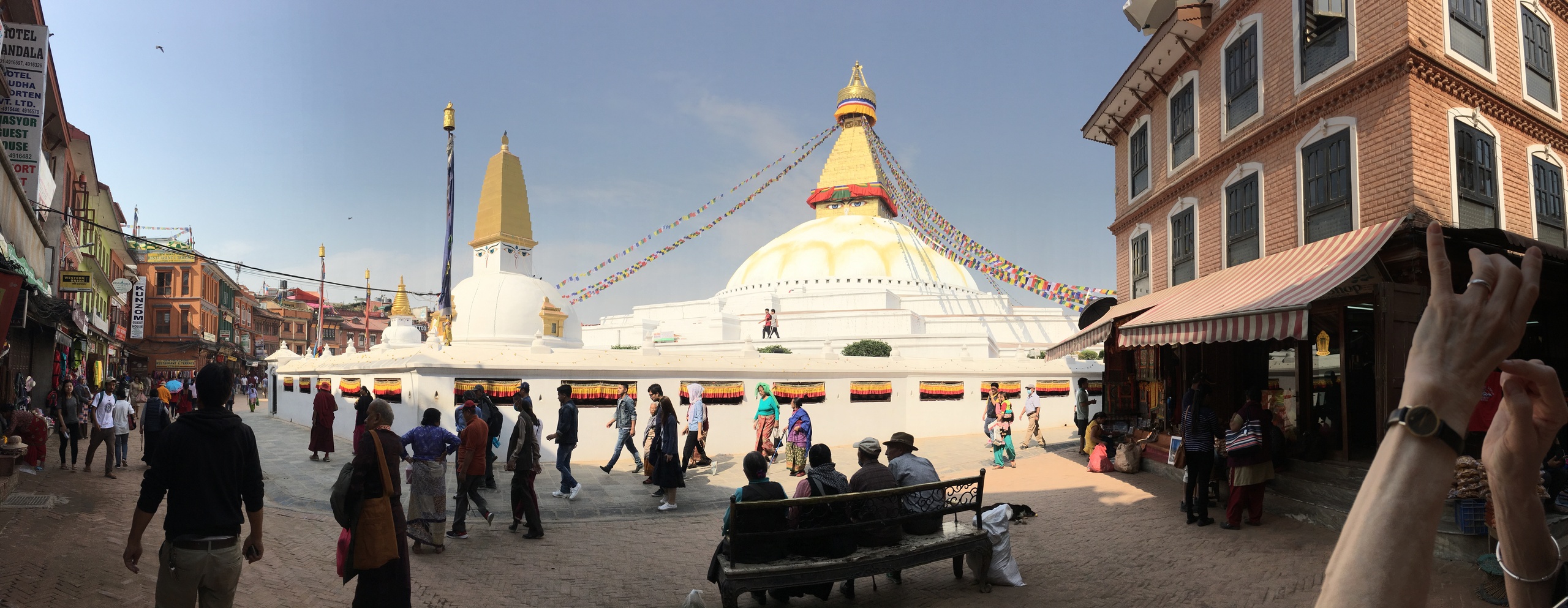
Above: The reconstructed Stupa at Boudha
Claire and Peter returned to Nepal in April with long-term supporters and good friends Dave and Darby. After a few days in Hong Kong to settle the jet lag associated with the 12 hour time change, they arrived in Kathmandu April 28, were met by Dr Prakash and taken by minibus to the Happiness Guest House near Boudha, the Tibetan area of Kathmandu 20 minutes walk from the Nepal Orthopaedic Hospital in Jorpati (where SIRC began its life 15 years ago) and to Raju’s family. A few minutes walk in the other direction revealed that the post-earthquake tent city, ironically next to the Hyatt Hotel, had just disappeared; new buildings were in evidence; the major road to Boudha and Jorpati was being widened by the partial demolition of buildings beyond their legal footprint, and city water from the distant Melamchi River was being piped into the city. The temporary effect of this work was that the potholes were much worse than usual as the water mains were buried under the road. Kathmandu was preparing for its first municipal election in 20 years. We visited with Raju and Sheela (expecting their firstborn in a few months) and Prakash, Laxmi and a very lively 19-month old Ritika.

Our major goal for the trip was to offer mentorship and a ‘sounding board’ on Dr Raju’s return to a very different role from the one he had before. We finally met Dr Christine Groves (seen left with new Admin Director Sanjeeb) who had been a great support to the two junior physicians (Drs Arjun and Abhishek) then providing routine clinical care. A big “Thank You” was due to the BSMMU faculty for having the faith to accept him and to train him over the last five years. Part of Raju’s SCI training came from around the world in the form of support for him to attend conferences and visit other centres – these had included: the Irish National SCI Centre, the Indian Spinal Injury Centre and rehabilitation training centres in Melbourne, Toronto and Vancouver, the latter two in association with attendance at the PM and R review course in Toronto. A further wonderful opportunity (and a logistical challenge) had presented itself a few days before we left for Nepal, when we learned that the SIRC SCI multidisciplinary team was to leave on April 29th for Switzerland as guests of the Swiss Paraplegic Centre (the SPZ)in Nottwil. As these were the people that Raju would be working closely with, this clearly presented a real opportunity for him to work closely with his colleagues sharing a stimulating learning experience. Thanks to SpiNepal supporters, we had sufficient funds in hand to cover his expenses in joining them without displacing another team member. Our Swiss colleagues were supportive, and the Swiss embassy in Kathmandu was extremely efficient in providing a visa within days so that Raju left May 2 for Zurich to join his colleagues from SIRC (below – thanks to the team for this photo).
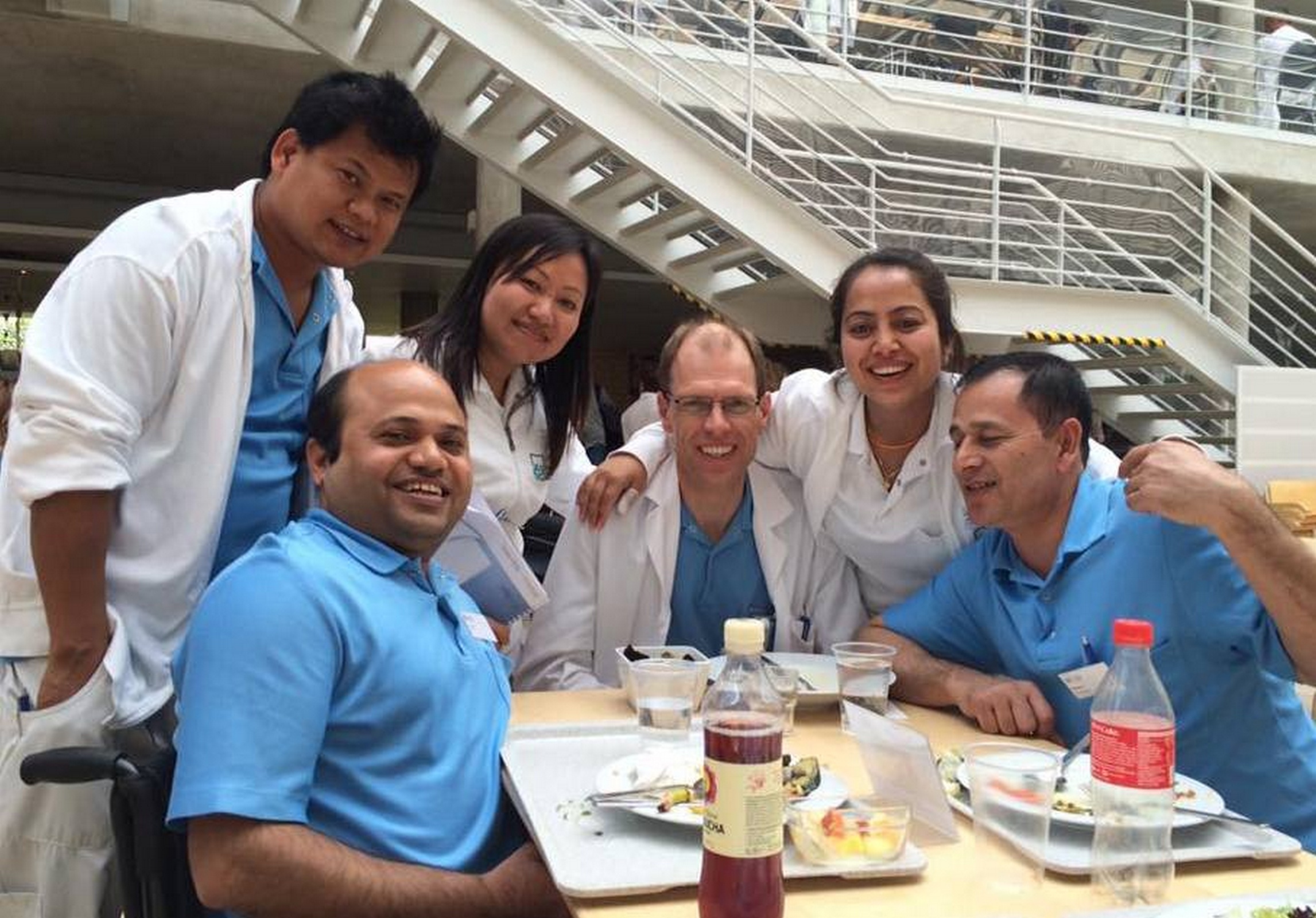
An interesting additional note: a newly formed international Cochrane Rehabilitation group was launched December 2016 to which Raju was invited to participate to represent his region. Unable to attend the ISPRM meeting in Argentina at which the group was to first meet in person, he rose at 2:30 am May 2 to join them via a conference call, prior to heading to the airport in Kathmandu. We missed some of our time with Raju in Kathmandu but it was much more important for him to be with his coworkers in Switzerland.
Prakash, continuing his active neurosurgical work at Bir Hospital, was still on a ‘daily’ casual employment basis and hoping for a time in the future when he might be accepted as a staff member. He had a poster on epilepsy treatment in Nepal accepted for an international meeting in Barcelona in September and was awarded partial support to attend that meeting prior to a three month neuroendoscopy training course in Germany to which he had been invited. (Congratulations, Prakash!) The four of us joined a number of his neurosurgical mentors and his former general surgical chief at a favourite restaurant (the Alice) as a delightful way to celebrate completion of his neurosurgical training. To complement this – we had a spectacular lightning display that evening over Kathmandu and the foothills of the Himalayas to the north of us.
As of the end of April the major training phase of the SpiNepal project had thus been completed and both doctors ceased income support from SpiNepal. An important duty of a program like ours is to meet “bridging” needs that we were currently exploring to discuss in more detail on return home. For Dr Raju, we supported the costs of the course at SPZ. For Dr Prakash, we resumed income assistance for a couple of months to assist his attendance at the neuroendoscopy course and may need to consider assistance to support his application for a one-year spine surgery fellowship (which should be self-funding), the place yet to be determined, to qualify him to pursue a spine surgery practice at an academic level on return home.
May 3rd was like the old days for us. We were up early and walked through the Boudhanath area, where hundreds of people walk quietly around the majestic stupa, murmuring, working rosaries, spinning prayer wheels. We had a ten minute wait to watch the bustle on the Jorpati road, then it was on to the big yellow bus for the one-hour ride to SIRC. We met Sanjeeb, the new Administrative Director (read: COO) and talked with many old friends. We spoke with Prajjwal, formerly the Community Based Rehab worker visiting homes and arranging necessary modifications, now a manager with VOICE, a vocational training program. Claire and Darby joined the three MDs for rounds; Peter and David walked around the hospital and noted several significant structural changes; Peter and Claire joined Drs Arjun, Abhisek and Christine in a teaching session and later met with CEO Esha to learn more about the exciting changes.
We were really pleased with our visit to Nepal. SIRC had continued to grow despite challenges and, as of the time of our visit (see below), lack of a sustaining income from the government. Its carefully developed program was leading to the formation of a very significant rehabilitation centre.
What did we find at SIRC?
- An expanded physical plant. A new vocational training building, nearly complete, was to support programs bringing in 30 patients at a time for job training. A new array of solar panels has been added to the hospital roof; one array is dedicated to warming one ward through newly installed underfloor pipes, much needed for those patients whose temperature control is impaired.
- Two very good doctors. Dr Arjun and Abhishek (seen with the urologist below right) impressed us as careful and dedicated and both hoped for a future in the different aspects of care of patients needing neurorehabilitation.
- Full beds – there were patients in 51 of the 53 acute rehab beds. The beds put in place for the ‘surge’ after the earthquake have been used for the vocational program. With the new vocational building coming on line, beds were to be dedicated to the new stroke program planning to admit patients once full staff training is complete.

- Improving skills in managing the paralyzed bladder. The new urodynamic equipment was unfortunately in need of significant servicing (including sensor replacement), and minor changes were also needed to the space available. Weekly ward rounds were being made with a urologist (right).
- Pressure sores (PSs) continued to be a challenge, as they are in all spinal injury units. Team discussions during our stay (right) focused on the problems getting reliable data about the prevention and care of PSs after discharge. Deaths have been associated with pressure sores but the cause of death was often not accurately recorded. Reliable data are needed on each patient if effective changes are to be made in patient education.
- A new and amazing vocational program developed with the support and encouragement of the South Korean government and Korean spinal injury association. The new building which will support this was inaugurated just after we left.
- Solid administrative support from a number of very competent people, with a new operations manager who also impressed us with his understanding of the clinical issues.
- New exploration of mobility options – SIRC was working with the local university to explore the feasibility of local manufacture of suitable wheelchairs. We wish them luck with this initiative.
- We had a number of meetings at SIRC, reviewing ongoing needs for Drs Raju and Prakash and those of the patients for whom they care. PM&R training is planned for Nepal and SIRC is well positioned to aid this planning with Dr Raju and his good regional network of connections. We found the SIRC Board to be solidly committed to training in the field of PM&R.
Raju and the team’s month-long training in spinal cord medicine at the Swiss Paraplegic Centre (SPZ) in Nottwil was very successful. We met them all for a breakfast just before we left and found them brimming with enthusiasm and new knowledge. It was rewarding to sense the tremendous energy engendered in all of them by the trip. The team(s) from SPZ have consistently provided support and teaching over the years, and we share the gratitude of our Nepalese colleagues for the opportunity they were given this year.
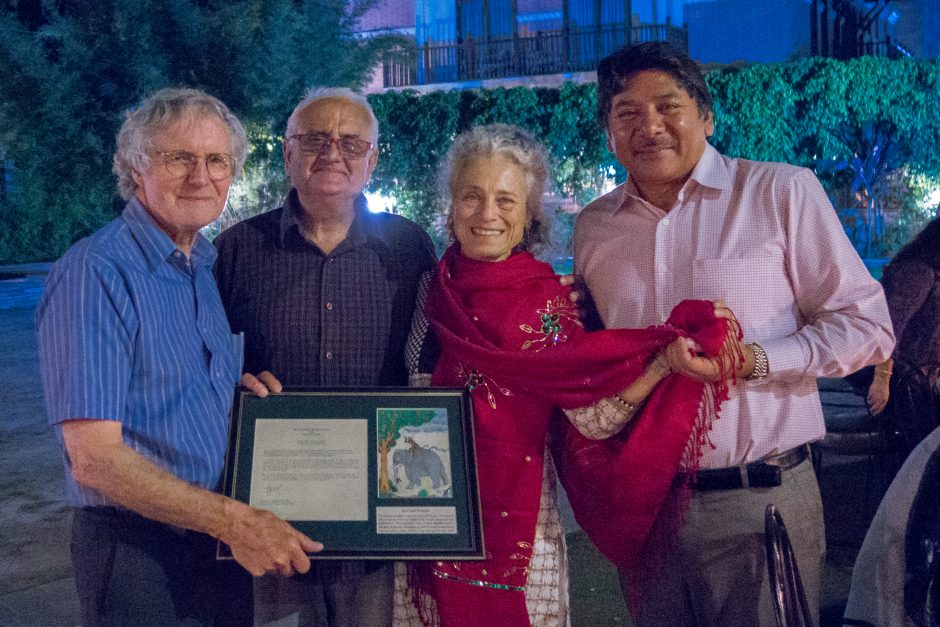
The completion of Raju’s training provided an opportunity to meet with and thank SIRC founding chair Kanak Mani Dixit (second from left in this photo, with current board chair Prachanda Bahadur Shrestha far right) and his fellow-board members as well as others in Kathmandu who have contributed to the development of SIRC. Kanak remains very politically active through his work as a writer and blogger – our thanks to him for drawing our attention to the Madhesi Youth Photo Project by Puru Shah here. (The Madhesi are the inhabitants of Nepal’s low-lying Terai region.) You may also be interested to look at some of Puru’s other work: the unhappy story of a Nepali work migrant’s problems in Saudi Arabia here and an excellent infographic about migration patterns in/from Nepal here – this is excellent use of interactive graphics following the stylistic approach of Gapminder – founder Hans Rosling would have been delighted to see this work.
June 2017 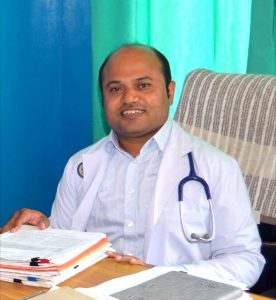
Dr Raju (right) was settling into his new life back in Kathmandu and work as the Medical Director at SIRC. He and his family were looking for new accommodation as he and Sheela were expecting a baby in October or November, so, with new clinical and administrative responsibilities, life was busy for him and he was seeking a way to travel to work each day in a way that is time efficient and that lets him work as he travels.
We received from SIRC links to an interesting video from the World Health Organisation regarding the role of rehabilitation after major disasters. Not surprisingly, SIRC features quite prominently in this, beginning with the opening scene shot soon after the earthquake. Please check our links page for more information.
August 2017
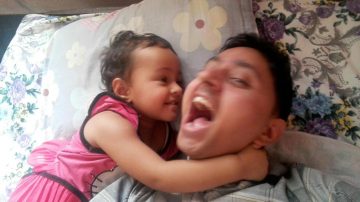 Good news from Dr Prakash – we were delighted to hear that he won the first newly-inaugurated gold medal (image top right) awarded for the highest marks earned on the first attempt in the 2016 Pakistani neurosurgical fellowship – top marks of 46 candidates. When we spoke, Laxmi was at work and Prakash was playing with Ritika (left). With his visa now in hand, Prakash was planning to leave in another week for Barcelona for an epilepsy conference before going to Greifswald (see below).
Good news from Dr Prakash – we were delighted to hear that he won the first newly-inaugurated gold medal (image top right) awarded for the highest marks earned on the first attempt in the 2016 Pakistani neurosurgical fellowship – top marks of 46 candidates. When we spoke, Laxmi was at work and Prakash was playing with Ritika (left). With his visa now in hand, Prakash was planning to leave in another week for Barcelona for an epilepsy conference before going to Greifswald (see below).
September 2017
Raju, after only a couple of months in his new position, exceeded our expectations as he assumed a number of administrative responsibilities, and was already being recognized for his role in shaping Nepal’s support for people with a disability. He was interviewed for a Nepalese online medical magazine “Hello Doctor” providing an explanation of the need for an integrated system of care for those with SCI including prevention and prehospital care, acute care, rehabilitation and community reintegration. He also discussed the ideal referral system which includes a medical data system which can coordinate care and research. (If you would like to watch it, be aware that it is 95% Nepalese: https://www.youtube.com/watch?v=6uRJrYvn0FE )
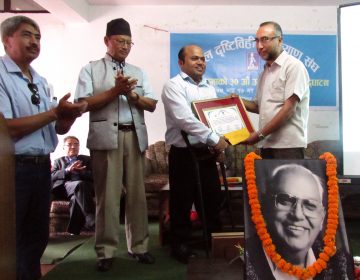
Raju was a panelist in Nepal’s first National review and planning workshop on disability, developing a disability action plan. He was the first person to receive the Keshabati Maskey Disability Excellent Service prize (right). (Keshabati Maskey was a UN official, had a SCI during diving for which she was treated in the UK.) This award is given by the Nepal Association for the Blind, an organization that also supports those with other causes of disability. A Felicitation ceremony recognized his significant contribution enhancing awareness of the needs of people with disabilities for a productive life, their rights and dignity, treatment and rehabilitation – and he received a cash award.
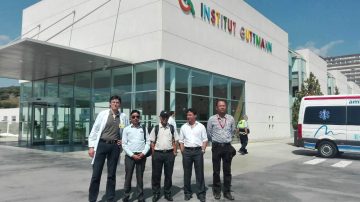
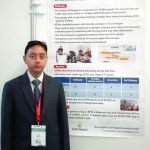 Meanwhile, Prakash presented at an international epilepsy meeting in Barcelona a poster on the management of epilepsy in Nepal (left). He and his team visited the Guttmann Institute, a large neurorehabilitation hospital inaugurated 52 years ago following the principles of Sir Ludwig Guttmann.(Right: Guttmann Institute host Dr Jesus Benito Penalva on the left, Kathmandu neurosurgeon Dr Hemav Rajbhandari far right.) We look forward to hearing their impressions of the work done there.
Meanwhile, Prakash presented at an international epilepsy meeting in Barcelona a poster on the management of epilepsy in Nepal (left). He and his team visited the Guttmann Institute, a large neurorehabilitation hospital inaugurated 52 years ago following the principles of Sir Ludwig Guttmann.(Right: Guttmann Institute host Dr Jesus Benito Penalva on the left, Kathmandu neurosurgeon Dr Hemav Rajbhandari far right.) We look forward to hearing their impressions of the work done there.
Prakash also had time to visit the Sagrada Familia cathedral and enjoy paella with a Nepalese friend now living in Spain. Next stop: Berlin and Greifswald in northern Germany for his three month neuroendoscopy fellowship.
Raju was busy both clinically and as a medical manager working within the multidisciplinary team (MDT). For example, the SIRC team had to focus again recently on challenges with wheelchair supply: there was a scarcity of wheelchairs at the centre most of the time. The MDT is always working hard to maintain a high level of care for people with SCI with the goal of reduction of complications. Urodynamic assessment (necessary to ensure safe management of bladder function) had now become a routine part of the care program during each patient’s stay at SIRC, following some initial technical problems with the equipment.
We were sorry to hear that colleagues Drs Arjun and Abhishek (two very good physicians, who we met when we were there in May) had left SIRC to explore other training opportunities. Raju was now supervising two new physicians docs as they learn the essentials of spinal cord medicine.
Prakash soon settled into Greifswald, Germany with accommodation found through AirBnB a windy 3-4 km bike ride to the clinic. He found the clinic and OR are of high quality. His work day began at 07:30 with rounds (in German, translated later; the images help). Two Chinese neurosurgeons were also doing the three month fellowship/course with him. Because his supervisor travelled quite a bit, affecting the volume of endoscopic cases, Prakash established a link with two orthopedic spine surgeons and was taking advantage of this access by learning spine surgical techniques. We spoke to him in Prague where he had gone for the weekend with his two colleagues. They went by bus as the fare is much better than train; Prakash was impressed with the smoothness of the road compared with those of Nepal!
He participated in a workshop-based course in his hospital: the “9th Baltic Sea, International Hands-On Course on Full HD Endoscopic Neurosurgery” organized by his supervisor Dr Henry W. S. Schroeder. You can find more details of this course at: http://ifneuroendoscopy.org/wp-content/uploads/2016/11/Flyer-Baltic-Sea-2017.pdf
October 2017
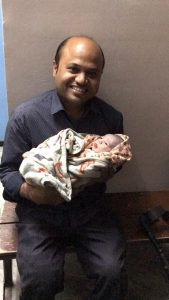 On Oct 17 Baby Dhakal was welcomed into Raju’s and Sheela’s family. Following Nepali custom, she was initially referred to as ‘baby’, and the name chosen over the next few weeks. Her proud parents are “enjoying all the activities (crying, laughing, sneezing, cleaning urine and stool) done by baby girl”. By late November we learned that she was to be called ‘Evani’, a name meaning ‘Alive’ and ‘Earth’.
On Oct 17 Baby Dhakal was welcomed into Raju’s and Sheela’s family. Following Nepali custom, she was initially referred to as ‘baby’, and the name chosen over the next few weeks. Her proud parents are “enjoying all the activities (crying, laughing, sneezing, cleaning urine and stool) done by baby girl”. By late November we learned that she was to be called ‘Evani’, a name meaning ‘Alive’ and ‘Earth’.
Working around the normal demands of a new infant at home Raju presented at the Association of Spine Surgeons of Nepal meeting. His talk was reportedly well received indicating that the spine surgical community recognizes and acknowledges the need for and importance of the work being done by Raju and the team at SIRC. He was becoming a good ambassador for rehab and the hospital: his responsibility as medical liaison with acute-care surgeons and services is to ensure that the core principles of SCI rehabilitation are applied as early as possible after injury.
November 2017 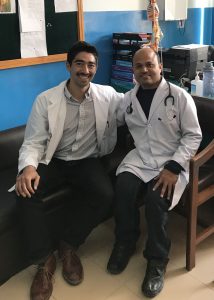
Dr Jordan Farag, a rehabilitation resident (specialist in training), based at Vancouver’s GF Strong Rehabilitation Centre, met Raju on his Vancouver visit in 2016. Jordan travelled to Nepal this month and trekked with a friend around the Annapurna massif –his photographs document a magnificent trek – before joining Raju at SIRC. We received enthusiastic reviews of him and his work from Raju, grateful for Jordan’s rehab teaching skills which were of great assistance, relieving him of some of his teaching duties with the two current junior physicians and participating in clinical rounds. Jordan’s debrief confirmed our opinion that a resident travelling to Nepal to provide support should be at a minimum at or above the R3 level with completed rotations in neurorehabilitation.
We were delighted to hear that the funding situation in Nepal has improved for people with new spinal cord injuries. From September 100,000 NR (about 1250 CAD) per patient had been made available by the Ministry of Health through 63 approved hospitals, as a significant contribution to the costs of inpatient rehabilitation and provision of a wheelchair and assistive devices. To date the care of about 53 patients has been funded through this program. We congratulate the hospital and the Ministry of Health in reaching agreement on this program and hope to report further on this development as SIRC gains experience.
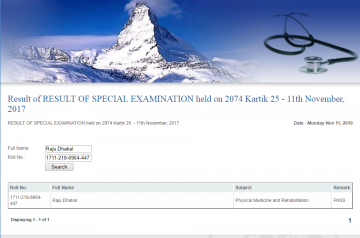 As the last step to Raju becoming Nepal’s first registered PM&R specialist, he successfully completed his specialty licensing exam in Nepal. Questions for the exam had been taken from a number of sources, especially the American Board exams, and we are sure that his participation in the Canadian PM and R review course in 2016 prepared him well for all his exams, including this one. Congratulations again, Raju! (And thanks to our Canadian physiatrists.)
As the last step to Raju becoming Nepal’s first registered PM&R specialist, he successfully completed his specialty licensing exam in Nepal. Questions for the exam had been taken from a number of sources, especially the American Board exams, and we are sure that his participation in the Canadian PM and R review course in 2016 prepared him well for all his exams, including this one. Congratulations again, Raju! (And thanks to our Canadian physiatrists.)
SIRC continued to be busy this fall; Raju reported that: “Many new things and responsibilities added on my shoulders in my working place. e.g Friday – Neuro-urology clinic which I have to run most of the time. Special PM&R clinic every day. I am planning for wound clinic (most likely Tuesday) very soon. We are working for stroke/TBI unit – Already started and 10 beds, all occupied but many things need to improvised. We have total 64 in patients right now. We have spinal unit-I, Spinal unit-II and Stroke unit.”
December 2017
Prakash returned home after a second neuroendoscopy workshop thus completing 3 months in Greifswald. He was able to spend a long weekend in Stockholm at the invitation of our great friend and hero Dr Claes Hultling learning about and visiting his Spinalis SCI rehabilitation program. After all, the results of surgery for spinal injury are only as good as the subsequent rehabilitation program. (If you have time to learn more about Claes and his work, watch the trailer for the made-for-Swedish-TV film “Africa – with a broken neck”. Better still, watch the whole film!)
TRAILER: Africa with a broken neck from Folke Rydén Production on Vimeo.
To watch the full movie, click here,
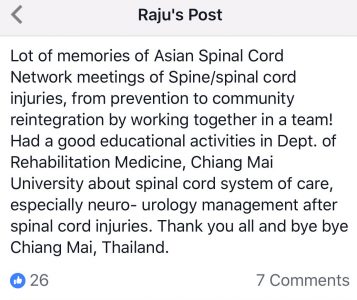 An essential part of practice in the field of SCI is to learn from local and regional mentors and peers. To this end, SpiNepal supported the attendance of Dr Raju and the SIRC psychologist, Sai Laxmi Rai, at the annual meeting and related workshops of the Asian Spinal Cord Network (ASCoN) in Chiang Mai, Thailand. Following the meeting the two professionals spent additional days working beside and learning from the Chiang Mai distinguished faculty. First reports of this were very positive: Raju’s comment (right) was from his FaceBook page, and he is seen below with regional colleagues at the ASCoN meeting.
An essential part of practice in the field of SCI is to learn from local and regional mentors and peers. To this end, SpiNepal supported the attendance of Dr Raju and the SIRC psychologist, Sai Laxmi Rai, at the annual meeting and related workshops of the Asian Spinal Cord Network (ASCoN) in Chiang Mai, Thailand. Following the meeting the two professionals spent additional days working beside and learning from the Chiang Mai distinguished faculty. First reports of this were very positive: Raju’s comment (right) was from his FaceBook page, and he is seen below with regional colleagues at the ASCoN meeting.
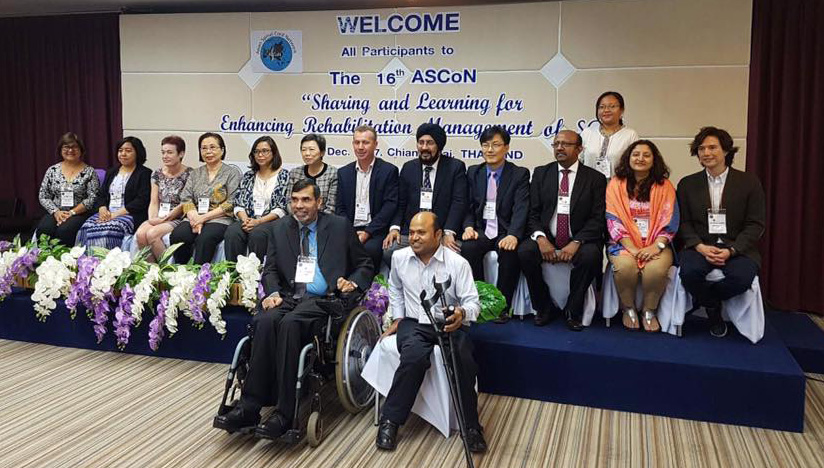
So – this was another rewarding year – especially so as our first phase of training two specialists in spinal injury is already showing results. As always, our friends and colleagues who administer and work in SIRC undertake the lion’s share of the perseverance, the planning and work of caring for those in need of spinal cord care – they inspire us to keep up our efforts. Congratulations and sincere thanks to all of you who have contributed in so many ways – this has been a real team effort!
